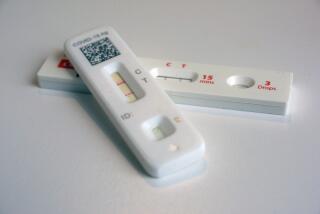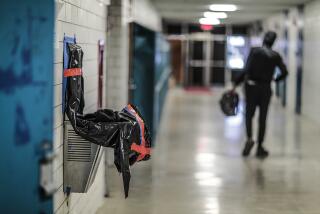Fast Test for Toxic Lead Is Approved
- Share via
WASHINGTON — Federal officials Monday approved the widespread use of a simple new technology that can quickly test children and adults for lead poisoning, which causes learning disabilities and behavior problems and afflicts some 310,000 children in the United States.
The new machine is smaller than most laptops and provides results in minutes. In most cases, this eliminates the need to send a blood sample to a lab and wait several days for results.
But funding problems may slow distribution of the devices, which cost about $2,200 each. Although the government has set a goal of eradicating childhood lead poisoning by 2010, it has not offered financial aid to speed adoption of the technology.
One-stop diagnosis is considered key to combating the problem because it enables medical personnel to offer immediate guidance to parents on how to help their children.
Acting Food and Drug Administration Commissioner Andrew C. von Eschenbach estimated that the testing device could be used in as many 115,000 locations nationwide, including health clinics, schools, mobile labs and workplaces. “Before today, [testing] was only available in certain settings, like hospitals,” he said.
Asked whether federal funds would be available, Von Eschenbach responded, “None that I can speak to.”
An official from the Department of Housing and Urban Development, which took part in the announcement, said communities might be able to tap existing anti-lead grants, but they would have to apply.
The nonprofit Coalition to End Childhood Lead Poisoning is trying to raise private funds to outfit vans as mobile testing centers. Though its executive director, Ruth Ann Norton, praised approval of the testing device, she also cited financial “obstacles.”
“Funding would be a really smart idea,” she said. “Even in the absence of that, communities will still have to act and push the government and the states.”
Madeleine A. Shea, the head of Baltimore’s lead-poisoning prevention program, agreed that cost “can be a barrier.”
“The whole concept of rapid testing is very important to our efforts,” she said. “A good test that can be easy to implement is critical.”
Though significant progress has been made in combating lead poisoning, experts say the gains are uneven and it’s unclear whether the 2010 objective will be met.
In Los Angeles County annually, about 1,200 children younger than 6 are found to have elevated lead levels.
Lead poisoning is most commonly caused by children’s ingestion of dust or other residue from lead-based paints. Lead paint was banned for residential use in 1978, but about 40% of the nation’s housing still contains some.
Low-income areas are disproportionately affected, but experts say many older homes in more affluent neighborhoods also have problems. The lead can be released during remodeling.
Medicaid pays for lead tests for low-income families, and federal guidelines call for testing all Medicaid recipients at ages 1 and 2.
But fewer than 25% of such children are tested.
Some local officials think rapid-testing technology could change that.
“Now we have a test we can take to children,” said Dr. John O. Agwunobi, assistant secretary for Health and a pediatrician. “Now we have a test that can get results while they are there.”
Specifically, FDA regulators determined that the Magellan Biosciences device could be used safely and accurately by nurses, doctors and others with minimal training. All the patient has to provide is a bit of blood by having a finger stuck with a sterile pin.
The availability of rapid testing increases the likelihood that more children will be tested.
And though a positive reading would require a second test for confirmation, doctors and nurses could recommend immediate steps for parents to help lead-exposed children -- such as getting the child away from contaminated paint.
*
ricardo.alonso-zaldivar@
latimes.com
More to Read
Sign up for Essential California
The most important California stories and recommendations in your inbox every morning.
You may occasionally receive promotional content from the Los Angeles Times.













